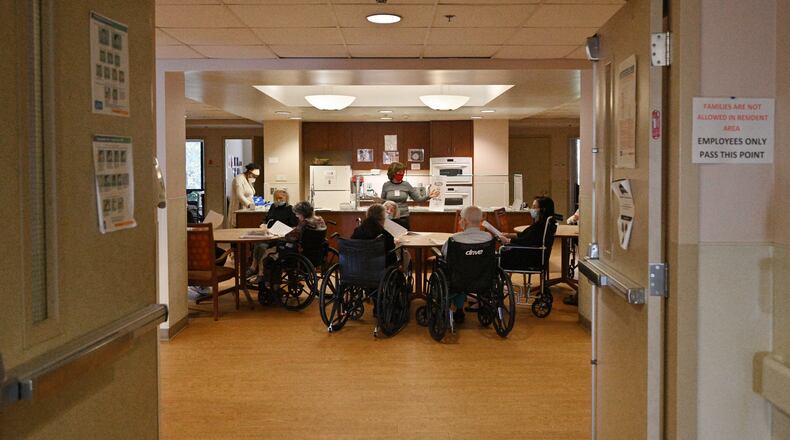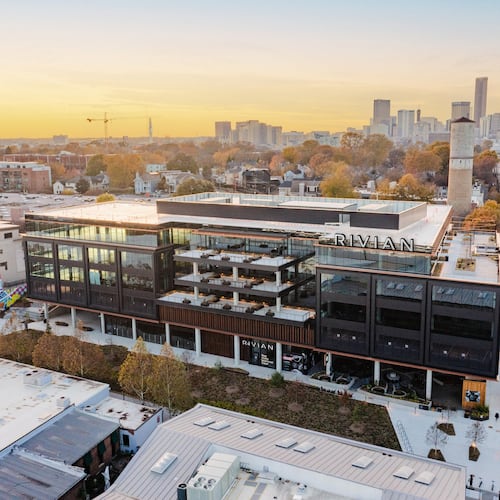As a new COVID variant surges, those in charge of caring for some of the nation’s most vulnerable, like nursing homes administrators, say they are better prepared to handle potential outbreaks of the virus because of lessons from earlier surges.
Perhaps the biggest difference between this current and previous surges is that most residents and staffers at nursing homes are now fully vaccinated with at least two shots and there are better safety protocols in place.
Another important lesson learned was the importance of visits by family and friends. During the previous outbreaks, visitation limits were introduced and stayed in place at many facilities until late 2021.
“There was some pushback, but most people understand it was for the health and safety of residents,” said Tony Marshall, president and CEO of the Stockbridge-based Georgia Health Care Association, a non-profit association of skilled nursing centers. Some of the problems caused by social isolation “were as significant as those caused by COVID.”
The organization represents more than 367 facilities with more than 39,000 beds. “Most people thought that it was proper to do, but they were not thinking it would be a two-plus-year event. Right now you’re allowed to visit, but with limited exceptions, you can’t visit those who have active COVID cases.”
In-person visits can ease anxiety, improve morale and emotional wellbeing and the presence of family can also put an extra set of eyes on a patient’s needs, according to experts.
The Centers for Medicare & Medicaid Services, a federal program that provides health coverage through programs such as Medicare, Medicaid and the Health Insurance Marketplace, has recommended people wear masks and get temperature checks but said the doors should remain open to visitors.
Some say that’s flirting with danger, but others say the toll from not allowing people to visit their loved ones created its own set of problems, creating anxiety, fear and depression among both residents and family members.
In the height of the pandemic, relatives and friends were restricted to seeing their loved ones during video chats, window visits, phone calls and later were allowed outdoor in-person visits.
The latest coronavirus subvariant — BA.5 — is more contagious than previous versions, evading individual immunity from past infections or protection from vaccines. While vaccinated and boosted people could still become infected with the virus, they are less likely to become seriously ill or die.
“The pandemic is not over,” said Ginny Helms, president of LeadingAge Georgia, an association that supports the not-for-profit and mission-driven organization that provide housing and services for seniors. However, “the good news is that vaccines and boosters have been effective so now most cases are mild and our elders are not at risk like they were. It was so scary.”
“This is just going to be part of our lives,” said Beth Laxton, executive director of the Sadie G. Mays Health & Rehabilitation Center in northwest Atlanta, where two residents were diagnosed with COVID last week. “We just have to take precautions ... and get vaccinated.”
Since Jan. 1, more than 114,600 people ages 65 and above have contracted the virus in Georgia, according to the state Department of Public Health.
And, although better prepared, nursing homes are still reporting a rise in cases among residents and staffers.
CDC data shows a steady increase in the number of individuals testing positive since the end of May. For the week ending July 10, there were 268 cases of COVID among residents in nursing homes and 336 among staff compared to 70 resident cases and 82 staff cases for the week ending May 29.
Since the pandemic began, there have been 1.11 million confirmed cases of COVID among residents of nursing homes and 1.18 million confirmed cases among staff nationally, according to CMS data.
Officials at Sadie G. Mays said all staffers are fully vaccinated with two shots and most have at least one booster and are encouraged to get the second. Staffers and visitors must wear masks and temperature checks are taken at the door.
There is also more frequent testing of staffers and residents.
If a visitor has COVID they are asked to come back when they are not positive.
Additionally, nearly all its residents in the 206-bed facility are vaccinated with 10 declining to do so.
Helms said the state and skilled nursing facilities have implemented infection control protocols and that ongoing training that will not only help them respond to future coronavirus outbreaks but “probably help with cases of the flu” in the fall.
“When the pandemic hit no one had ever seen anything like this. We started at ground zero,” she said. “Everyone rose up and learned.”
She said more needs to be done and would like to see funds available to have more single-bed room rather that two people sharing a room, which she thinks could cut down on transmissions.
According to figures from the Centers for Disease Control and Prevention’s National Healthcare Safety Network , as of July 3, the percentage of staff fully vaccinated in Georgia is 91.9% and residents fully vaccinated is 86.7%. Nursing homes are mandated to report this information.
Before her older brother died earlier this year, June Bell Blackmon remembers what it was like when the rehab and long-term care facility where her older brother lived after a debilitating stroke began limiting or stopping visits in 2020.
Before the pandemic, she and other family members brought food . They took him for long car rides and to the movies. They made sure he was clean.
The outings and being around family helped brighten his mood and hers as well.
Then the first big wave of COVID infections hit.
The facility went on lockdown and it was “horrific,” said Blackmon, a retired radiation therapist. “You knew the care was going to be good if you visited. In nursing homes you have to visit.”
The facility, like many nursing homes and long-term care facilities, had staffing issues. Several patients contracted COVID. At the time there were no vaccines. Even visits and activities between residents were stopped.
She could only talk with him by phone and on Facetime but soon that stopped as well.
He was depressed,” she said. “Not even seeing people there, I think, he sort of gave up.”
He died earlier this year from non-COVID related causes.
About the Author
Keep Reading
The Latest
Featured



